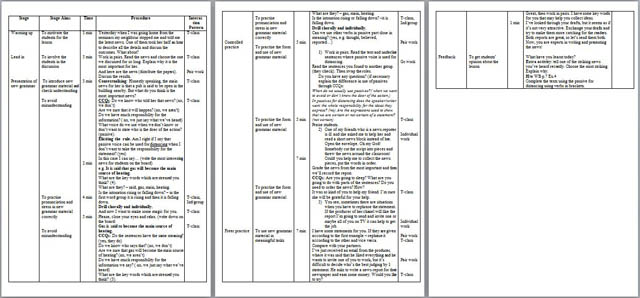Использование страдательного залога часто бывает проблематичным для учащихся, но в данном случае ребята справились довольно легко. Я надеюсь, что подробное пошаговое описание каждого этапа поможет коллегам провести урок также интересно, так как основной моей задачей было разработать урок так, чтобы ребята сами были активными исследователями языка, а учитель лишь направлял и уточнял...
Aims:
by the end of the lesson my students will be able to use passives for distancing in oral and written speech.
Sub-aims:
get general and specific info from audio and written texts;
practise the use of passives for distancing in controlled and freer activities;
analyse the use of passives for distancing;
Personal aims:
be patient;
correct students’ mistakes;
give students more talking time;
Language-based lessons (form, concept, phonology). This page is only for language-focuses lessons (i.e. grammar or functional language). Vocabulary focus should go on the other side.
What is the language form?
Include an example sentence that uses the TL and analyse it.
It is said that gas will become the main source of heating.
Gas is said to become the main source of heating.
It is said that gas will become the main source of heating.
This is a complex sentence, consists of two simple ones. The first sentence is simple, in passive voice where it is a subject, is said is a predicate in present simple present. The second sentence is compound in future simple active voice, where gas is a subject and will become is a predicate.
Gas is said to become the main source of heating.
This is a compound sentence in Present Simple passive, where gas is a subject, is said is a predicate, to become – an infinitive.
Concept(s)? When is this language structure used? Include concept checking questions and expected replies from Ss.
Passives can be used for ‘distancing’. This means that the speaker/writer doesn’t want the whole responsibility for the ideas they express. The passive is often used to make a statement less personal and slightly more polite.
In formal writing, when the focus is on achievements and events rather than people responsible.
The expressions are used to show that we are not certain of a statement.
It is said that gas will become the main source of heating.
Gas is said to become the main source of heating.
Do the sentences have the same meaning? (yes, they do)
Do we know who says that? (no, we don’t)
Are we sure that gas will become the main source of heating? (no, we aren’t)
Do we have much responsibility for the information we say? ( no, we just say what we’ve heard)

Any important phonological features to point out to students? (stress / intonation / connected speech / sounds etc)
It is said / that gas/ will become the main/ source of heating.
How many stressed words are there? – 4
What are they? – said, gas, main, heating.
Is the intonation rising or falling down? – in the first word group it is rising and then it is falling down.
What problems will learners have?
Form/meaning/phonology?
Mention your solutions.
1)They can mix up the structures.
It is said that gas will become the main source of heating.
The first part in this sentence is impersonal, the second part is a compound sentence joined to the first part with the preposition that.
Gas is said to become the main source of heating.
One compound sentence where the subject has the meaning, impersonality is expressed in the predicate and the infinitive carries the meaning.
Give controlled activities
2) Students can mix up passives in general and passives for distancing.
Explain that in passives for distancing the speaker/writer doesn’t want the whole responsibility for the ideas they express and the expressions are used to show that we are not certain of a statement.
Earlier we studied that passives are used when we want to avoid or don’t know the doer of the action.
Stage.
1. Warming up.
To motivate the students for the lesson.
Yesterday when I was going home from the seminars my neighbour stopped me and told me the latest news. One of them took her half an hour to describe all the details and discuss the outcomes. What about?
2. Lead in.
To involve the students in the discussion.
Work in pairs. Read the news and choose the one we discussed for so long. Explain why it is the most important for her.
And here are the news (distribute the papers).
Discuss the results.
Весь материал - в документе.

 Получите свидетельство
Получите свидетельство Вход
Вход



 t is said / that gas/ will become the main/ source of heating.
t is said / that gas/ will become the main/ source of heating.
 as / is said to become the main/ source of heating.
as / is said to become the main/ source of heating.








 План урока по английскому языку на тему "Use of Passives For Distancing" (85.5 КB)
План урока по английскому языку на тему "Use of Passives For Distancing" (85.5 КB)
 0
0 1256
1256 78
78 Нравится
0
Нравится
0


